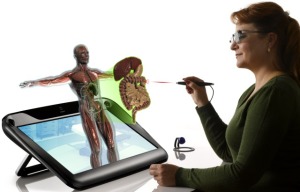by
Carol Ko, Staff Writer | October 31, 2013

zSpace's holographic images
help medical students
visualize anatomy
When pressed to explain the value of 3-D virtual holography, Dave Chavez, CTO of holographic computing firm zSpace, gave a surprising answer: it's because we have two eyes.
In fact, most complex organisms have two eyes, which begs the question — why not just one eye? Why not three? "Two eyes is exactly the right number to deal with the spatial environment in which we live," Chavez explained.
"It allows us to navigate, process and interact with the world in front of us in a much more powerful and efficient way. It's worth the extra energy and complexity to have that second eye."



Ad Statistics
Times Displayed: 172926
Times Visited: 3140 For those who need to move fast and expand clinical capabilities -- and would love new equipment -- the uCT 550 Advance offers a new fully configured 80-slice CT in up to 2 weeks with routine maintenance and parts and Software Upgrades for Life™ included.
Though we're biologically programmed to interact with a three-dimensional, spatially complex world, most of us spend the majority of our days staring at a flat screen — a disparity that may have real implications for the medical profession, which requires advanced spatial skills and processing.
Madeleine Keehner, a research scientist for the Educational Testing Service and director of the Spatial Cognition Laboratory at the University of Dundee in Scotland, studies the role of spatial cognition and image processing in medicine.
Her research argues that because 2-D pictures are essentially an artificial representation of a 3-D object, interpreting images is a cognitively intensive process for physicians.
Under the right circumstances, she says, 3-D computer visualization tools can help enhance learning and cognition.
"You would look at that data completely differently. Since you're wired to deal with the info, you don't have to interact with an artificial representation of these planes — you can see additional anomalies and details," says Chavez.
Virtual surgery
Because the technology is so new, there's a relative dearth of research around the benefits around 3-D virtual holography for pedagogical purposes, but nevertheless, interest is still high: zSpace is now helping first year medical students at Touro College dissect virtual bodies without ever having to touch a cadaver.
Using a large screen, glasses and a pointer, students can interact with and manipulate 3-D images, including examining it from all angles and zooming in and out.
The advantages of this technology are, first and foremost, practical: while holographs can't entirely replace the need for real cadavers, they are expensive and time-consuming to prepare for dissection. By using holographic technology, medical schools can aid students in spatial learning without the economic constraints of buying and using real bodies.

